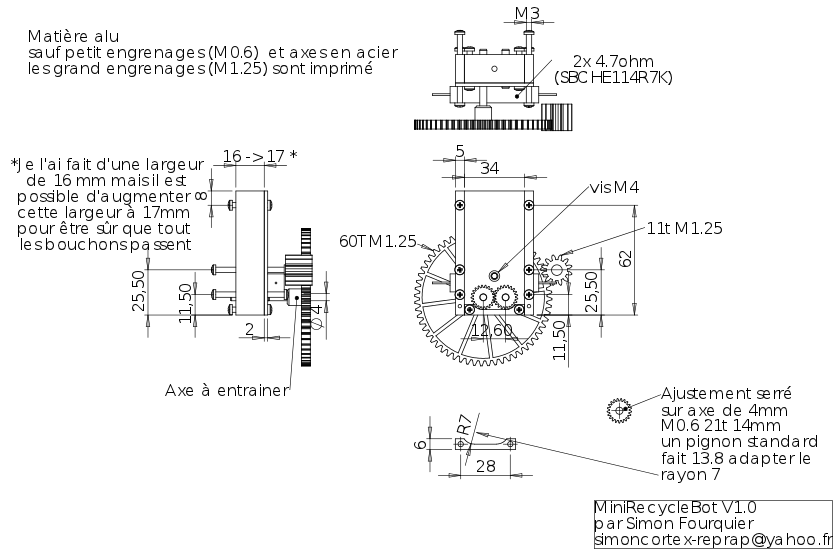MiniRecyclebot
|
English • العربية • български • català • čeština • Deutsch • Ελληνικά • español • فارسی • français • hrvatski • magyar • italiano • română • 日本語 • 한국어 • lietuvių • Nederlands • norsk • polski • português • русский • Türkçe • українська • 中文(中国大陆) • 中文(台灣) • עברית • azərbaycanca • |
This page is under construction. The main version is in French.
Contents
MiniRecyclebot
The MiniRecyclebot is a smaller alternative to the Recyclebot that turns plastic caps or other plastics scraps into 2-3 mm filament.
Video
Prototype video: http://www.youtube.com/watch?v=XhsRjhnGQ7s
Operation
The device is based on the principle of a gear pump.
Operating principle:
- A hopper is filled with plastic caps (or any recyclable plastic).
- The hopper is heated to ~200°C.
- A gear pump draws the molten plastic downward.
- The molten plastic is drawn through a 3mm tube.
- Finally, the plastic is stretched by a pair of rollers. By adjusting the rollers speed, it is possible to control the final diameter of the filament.
Blueprints
Mechanics
Main filament former
Media:Fondeur.svg Vector graphic drawing (SVG)
It must turn at constant speed. The prototype uses a stepper motor.
Rollers for shaping the final filament
This has not been implemented yet but the principle is straightforward: pull the wire through two rubber wheels. Their speed will be kept constant with the use of stepper motors (see video).
Electronics
Two resistors are used to heat the chamber. If the system is thermally isolated, 60W should suffice. One could use, for example, two ceramic 4.7 ohm resistors (model SBCHE114R7K) at 12 V, which will draw a total of about 5 A. (Beware that some PC power supplies will not handle this load)
A temperature controller is not necessary if insulation and power supply are carefully selected beforehand.
Stepper motor control can be performed from a PC through the parallel port, or from RepRap electronics with the appropriate firmware.
Here(?) is a small C program that controls two A4983 stepper motor drivers from the parallel port of a computer running GNU/Linux.
Plastic testing
Plastics can be identified by their resin identification code.
NYLON
Nylon can release toxic fumes when heated. Without additional information it is inadvisable to melt the nylon.
NOT TESTED
HDPE
High Density Poly Ethylene is used to make some plastic bottles and bottle caps. Also used in the food and chemical industries for its resistance to corrosion and solvents (food containers, fuel tanks, detergent bottles).
Material shrinkage after forming in the MiniRecyclebot: 3% to 3.5%.
Results
- Good filament extrusion
- Diameter constant to +/- 10%
- Small impurities led to small burnt patches on the filament. These do not affect performance nor damage the nozzle but are unsightly.
- Large deformation during printing.
LDPE
Low Density Poly Ethylene tends to be used to make bottle caps, mostly for water and other non-carbonated drinks. However this is not systematic since HDPE is also used as raw material. Was also used for low end packaging (plastic bags) but is being increasingly replaced by more eco-friendly plastics (such as PLA).
Material shrinkage: 1.6% to 3%
Results
- Good filament extrusion
- Diameter constant to +/- 10%
- Small impurities led to small burnt patches on the filament. These do not affect performance nor damage the nozzle but are unsightly.
- Test print using a small hollow model (30x20x30mm) with good results. Larger scale not tested yet.
PP
Polypropylene is used to make objects that are resistant to fatigue: boxes, large bottle caps, pipes; also bottles for milk and dairy products, medical or laboratory plastic items.
Material shrinkage: 1.5% to 2.2%
Results
- Initial tests failed.
- Filament diameter is not regular.
- When melted the material looks like bubble gum and does not flow well through the pump system.
- Should be tested at higher temperature.
PS
Polystyrene is a general purpose plastic used in different forms (sheets, expanded foam, extruded), popular for its economical price.
Material shrinkage: unknown, although High Impact Polystyrene and General Purpose Polystyrene shrinkage is between 0.3% to 0.6%.
Untested.
ABS
ABS's light weight and abilities to be injection molded and extruded make it useful in a wide range of applications. Though more expensive than polystyrene, it is harder and stronger.
Often used as printing material for reprap printers
Material shrinkage: Low 0.3% to 0.8%
Untested.
PLA
Polylactic acid is a biodegradable plastic, made from agricultural byproducts, used as replacement for non-biodegradable plastics in low end packaging, engineering plastics as well as some bio medical applications.
Often used as printing material for reprap printers.
Material shrinkage: none; seems to be no problem unlike all the other plastics. Also totally biodegradable.
Untested.
PET
Does not work: when heated seems to turn white and solid.
This might be caused because the melting point (~250'C) was not reached, as it is stated above that the funnel is only heated to around 200'C. -Lodorenos
Contact
Liens externe
- PEHD http://fr.wikipedia.org/wiki/PEHD
- PELD http://fr.wikipedia.org/wiki/Poly%C3%A9thyl%C3%A8ne_basse_densit%C3%A9
- Code d'identification des résines http://fr.wikipedia.org/wiki/Code_d%27identification_des_r%C3%A9sines
- source des taux de retrait http://www.thermoformage.com/moules-a-thermoformer
